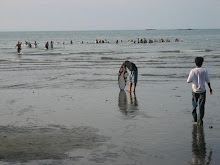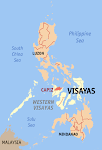 T
The City of
Roxas, once known as the municipality of Capiz is the capital of the province of Capiz.
In 1569, Captain Diego de Artieda who was sent by Miguel Lopez de Legazpi from Cebu, landed on the town of Pan-ay and proclaimed it as the capital. Later the capital was moved to its present site upon discovering that the town of Capiz was near the sea where they can have better docking facilities. The Spaniards saw the long coastal cover and envisioned a trading and shipping center. Ports were constructed in Libas and later in Culasi.
A river meanders across the town, cuts it at the heart and divides it almost equally into two. Tributaries from the mountains flowed into the head of Panay River through settlements formed along its shores, irrigating and fertilizing the land to provide food to the people. Following its course into the sea, it provides water to fishponds during high tide.
In 1590, the Navy of Acapulco, Mexico made Capiz port its arsenal (naval yard) where they can seek shelter when the sea was rough. Capiz then eventually grew into a bustling port and several houses of stones were built. The social and political status enjoyed by the native chieftains of Capiz often resulted in mixed marriages with the Spaniards. The mestizo descendants became the base of the principalia or influential citizens. Their privileged positions allowed them to build houses around the favored square of the poblacion - around the church and the government complex. Their children became the beneficiaries of the Augustinian mission in 1593.
In 1746, Capiz was made the seat of the politico-military government, although it was ecclesiastically controlled by the Bishopric of Cebu. In the latter part of 1795, under Gobernadorcillo Miguel Bautista, the old road to Baybay Beach was built as an extension of San Roque Street.
The town of Capiz was frequently attacked by Muslims that in 1814, stone forts at Baybay Beach (Baluarte) were built through the initiative of Gobernadorcillo Jose Consolacion.
In 1870, the ground was broken for the foundation of the Cathedral of Capiz under the guidance of Reverend Apolonio Alvarez. It was built by sturdy hands, sweat and blood of Capizeños who were victims of forced labor.
In 1876, the diocese of Jaro in Iloilo was erected and Capiz came under its jurisdiction. In 1877, the cathedral was finally finished. Prior to its construction, a chapel was built in Burgos Street beside the municipal building.
In August 1899, the Spanish colonial government represented by Governor Juan Herrero formally surrendered to General Ananias Diokno in Baybay Beach.
Economic debacle hit the town of Capiz in 1914 when the Ayala Distillery grounded to a halt. What could have been an ambitious forerunner of nationalized industrialization became the victim of the Internal Revenue Law under American control.
In 1917, Division Superintendent of Schools F.E. Hemingway founded Capiz Trade School for intermediate pupils and offered woodworking as the only vocational course. The next division superintendent opened Capiz High School.
In 1926, Division Superintendent Arthur Wittman authorized teaching of complete secondary curriculum in the Capiz Trade School. In the same year, Culasi Port was built to accommodate inter-island ships.
On February 15, 1951 the diocese of Capiz became a separate ecclesiastical jurisdiction from Jaro. Its first bishop was Msgr. Manuel Yap. In the same year, former Vice Mayor Libertad Conlu became the first female mayor of Capiz.
Capiz became a chartered city on May 12, 1951 through House Bill 1528 sponsored by Ramon Acuña Arnaldo, the representative of the First District of Capiz. It was approved by President Elpidio Quirino on April 11, 1951 as Republic Act 608. Consequently, the town was named Roxas City after her greatest son, President Manuel Acuña Roxas, the last president of the Commonwealth and the first president of the Philippine Republic.
The first appointed mayor was Lorenzo Acuña Arnaldo followed by Ramon Berjamin Blanco, Jose Dorado and Juliano Alovera Alba. In 1959, Lorenzo Acuña Arnaldo again became the head of the city as the first elected mayor. The next mayor was Teodoro Roxas Arcenas who was succeeded by Juliano Alovera Alba who was also the representative of the First District of Capiz at the House of Congress when Martial Law was declared.
Hon. Antonio A. Del Rosario, who is now the Congressman of the 1st District of Capiz, was elected to three terms as mayor of Roxas City, serving from 1998 to 2007.
 Roxas City-is a medium-sized city in the province of Capiz, Phillipines. It is the capital and component city of Capiz. The current city mayor is former provincial governor Vicente Bermejo who was elected during the 2007 election
Roxas City-is a medium-sized city in the province of Capiz, Phillipines. It is the capital and component city of Capiz. The current city mayor is former provincial governor Vicente Bermejo who was elected during the 2007 election













